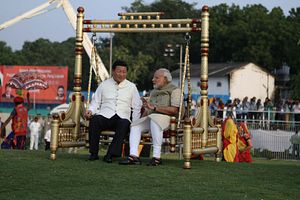India’s domestic and international economic choices have not always been the wisest.
At independence, India was determined to transcend the distorted pattern of economic integration with the world that two centuries of exploitative colonialism had engendered. But in the process, it ended up effectively locking itself out of global trade and investment flows altogether—just at the time when advanced countries were tearing down their mercantilist tariff walls to make way for the liberal, post-war trading order.
Central planners in New Delhi foisted an import substitution industrialization model of development, one suited to middle-income, primary-product exporters, upon an impoverished agrarian society. In doing so they condemned all but a privileged pocket of urban and public sector employees to the margins of the modern economy.
Two decades later, as East and Southeast Asia’s tiger economies were taking advantage of Japanese firms’ outward direct investment (ODI) strategies to make labor-intensive and export-oriented manufacturing activities the centerpieces of their inclusion programs, New Delhi ushered in the high noon of license-raj socialism. To this day India’s employment protection legislation in the formal manufacturing sector remains among the most restrictive in the world. The share of manufacturing goods in India’s exports is declining. And Indian and South Asian small and medium enterprises are mostly absent from Asia’s dynamic vertically-integrated, production-sharing chains.
India and Pakistan were founding members of the General Agreement on Tariffs and Trade (now the World Trade Organization), yet at its very outset opted to write a prohibitory exception to mutual trade relations into its rules. In the bitterness of partition and their first war over Kashmir, New Delhi imposed a trade embargo to choke off the nascent Pakistani state—a legacy that has cautiously begun to be repaired since the late 1990s. Regionally, too, India to its detriment appears unable to purposefully engage within the current Regional Comprehensive Economic Partnership negotiations, despite the gradual evisceration by the West of the most-favoured-nation principle in the multilateral system.
A once integrated subcontinent is now among the least integrated spaces in the world. India must take the lead in restoring the economic unity of the subcontinent. The subcontinent’s economic links to East Asia remain insubstantial. India must exercise a leadership role in constructing multiple lines of communication that imaginatively network the subcontinent with production processes and final markets in East Asia and the Pacific.
India must not pass up the latest grand opportunity presented by China’s ambitious ‘One Belt, One Road’ initiative to build complementary cross-border connectivity links that both bind it to the periphery and integrate it via the ‘belt’ and the ‘road’ to global networks, while respecting the interests of all parties involved. Elevating the periphery to the core of its relationship with China will also promote possibilities for Sino–Indian cooperation in Asia and undermine the geopolitical one-upmanship which has hitherto characterized their regional strategies.
In February 2014, at the 17th round of Special Representative talks in New Delhi, Beijing formally invited India to join its ambitious Maritime Silk Route (MSR) project. The Narendra Modi government should aim to make China’s activities in South Asia complementary to its own neighborhood policy. India should exert its influence to craft the contours of the MSR’s South Asian blueprint in order to chip away at the steep transaction costs associated with the subcontinent’s post-1947 borders. It should also draw up an integrated view of how the various proposals under the rubric of China’s ‘One Belt, One Road’ initiative—the MSR, the Bangladesh-China-India-Myanmar (BCIM) corridor, and rail, road and port development in Nepal, Pakistan, Sri Lanka and Myanmar—can be harmonized to serve both India’s peaceful rise within its extended Asian neighborhood and Asia’s peaceful rise to the forefront of world affairs.
At a time when New Delhi lacks the funds—and perhaps the intent—to underwrite the modernization programs of its common neighborhood, it must not be seen to undermine an initiative that it does not at any rate possess the wherewithal to subvert. ‘One Belt, One Road’ is the centerpiece of the Xi Jinping administration’s ‘new type of international relations’ concept—an imposing win–win scheme that aspires to embed the China Dream within a neighborhood community of common destiny. Co-opting ‘One Belt, One Road’ in South Asia will liberate New Delhi from its penchant to oscillate between viewing the subcontinent as its exclusive sphere of influence and longing to vault over the neighborhood to pursue flashier adventures abroad.
By recreating the famous historical land and sea routes along which commerce and civilization once traversed, ‘One Belt, One Road’ will also reawaken India in no small measure to its own golden age of cross-border contact. South Asia was once a great entrepot for commercial exchange between China and Rome. Asia’s seas were a genuine mare liberum (free sea) that no sovereign sought to control. The spread of Buddhism from South Asia along the ‘belt’ and ‘road’ wove a common world of religious-cultural ambiance and sensibility that signified both integration and cosmopolitanism.
Standing in the UNESCO offices in March 2014, Chinese President Xi Jinping extolled the profound impact of Buddhism on China. For his part, Modi, a firm devotee of the Buddha, commenced his recent China tour at a shrine built to commemorate a famous Chinese Buddhist monk who had visited his ancestral village in Gujarat during the Tang Dynasty era. A 21st century infrastructure project geared to connect the Asian heartland to its hinterland and beyond might yet revive a set of loose integrative norms, which can foster principles of order and self-restraint in East Asia and South Asia.
Modi, unrestricted by the blinkers of his elitist predecessors, should exercise his abundant leadership qualities to walk India and South Asia confidently down this path.
Sourabh Gupta is Senior Research Associate at Samuels International Associates, Inc., Washington, DC. This piece was originally published over at East Asia Forum here.

































